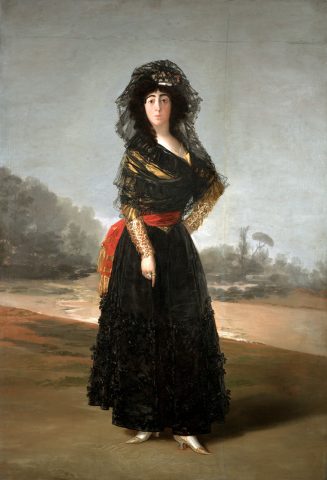London vs Paris: 60 portraits by Goya reply to the Medicis’ epiphany at the Jacquemart André
- Francisco de Goya, The Duchess of Alba, 1797. Oil on canvas, 210.1 × 149.2 cm. On loan from The Hispanic Society of America, New York, NY © Courtesy of The Hispanic Society of America, New York.
- Francisco de Goya, The Family of the Infante Don Luis de Borbón, 1783-4. Oil on canvas, 248 x 328 cm. Fondazione Magnani Rocca, Parma, Italy © Fondazione Magnani Rocca, Parma, Italy.
The match between Frieze’s art fairs and the Fiac is not the only one London and Paris are playing at the moment, and if also this year the Parisian contemporary art week is doing better – according to the main art dealers, who once again have reserved to the bright Grand Palais the very best of what they have – the London National Gallery replies to the ambitious “Portrait at the court of Medicis” exhibition at the Musée Jacquemart André with “Goya: the Portraits”, an impressive collection of more than 60 portraits by Francisco José de Goya y Lucientes tracing the Spanish artist’s career from his early beginnings at the court in Madrid to his appointment as First Court Painter to Charles IV.
Also in this case, the extraordinary loans granted to the National Gallery, from both public and private collections, suggest how helpful exhibitions of this kind are, offering the opportunity to see in just a couple of hours what has been done mostly at the Spanish court in almost 80 years and now is spread all over the world, from São Paulo to New York, and Stockholm to Parma, including the Prado, in Madrid, of course, where the Anglo-Italian art historian Gabriele Finaldi, director of the National Gallery, was working until last summer.
Among them, the iconic “Duchess of Alba” from The Hispanic Society of America Museum & Library; the portrait of “Don Valentin Bellvís de Moncada y Pizarro” from the Fondo Cultural Villar Mir, Madrid, which is unpublished and has never been seen before in public; “The Countess of Altamira and her daughter, María Agustina”, which has never been lent internationally from the Lehman Collection at the Metropolitan Museum of Art, New York; not to mention the monumental group portrait of “The Family of the Infante Don Luis de Borbón”, from the Magnani-Rocca Foundationin in Parma, that will be reunited with some of the other portraits Goya painted of the Infante’s young family.
If compared to the show at Musée Jacquemart André, which is also exclusively dedicated to portraits and can count on no less significant loans, that at the National Gallery is larger in scale and apparently more impressive. High ceilings and thick walls give to the aristocrats painted by Goya something that the French stylish home museum’s small rooms can’t offer: at the NG most of the prominent paintings are hung at the wall a bit higher than the visitor sight, sometimes forcing him to look to the picture from the bottom. It may inspire reverence, detachment, majesty, even if what the exhibition seems really to reveal is how the Spanish painter has been able to turn even the most unreachable person into a human being, who is at some point familiar with the painter, and consequently with the beholder. That is the case, for instance, of The Duchess of Alba, pointing with her right finger to the ground, where the name of the painter is written on the sand. More than just marking the relationship between the woman and the painter, this gesture – their love affair has never been proved – conveys a hint of her essence directly to the viewer. No body language studies are required to read into her mind, the painter already painted it as an open book.
October 24, 2015


